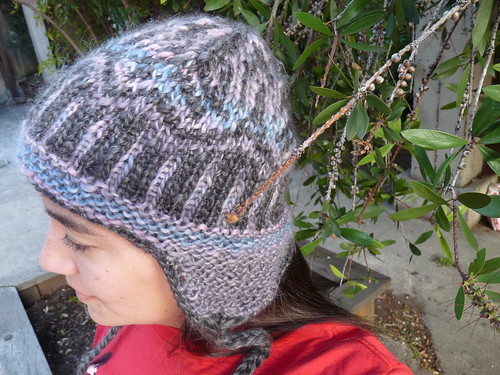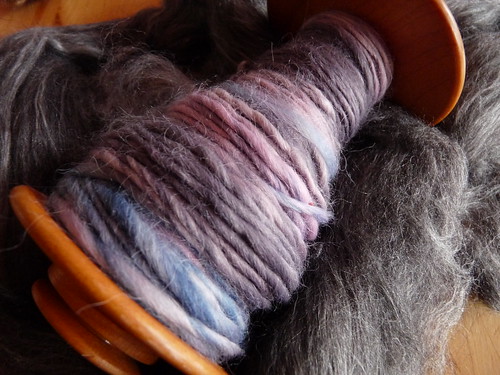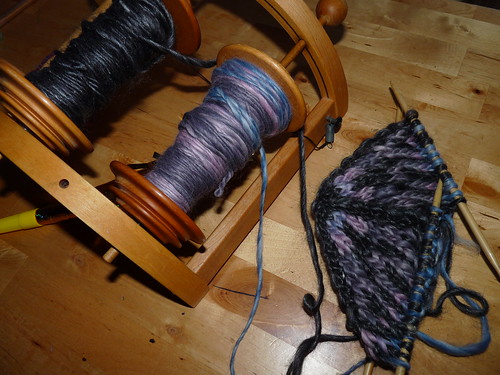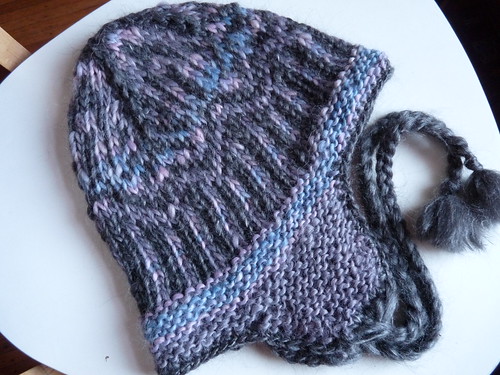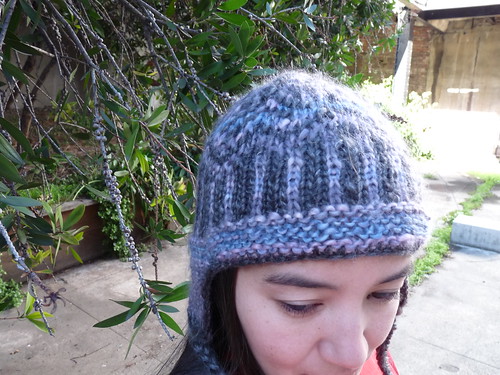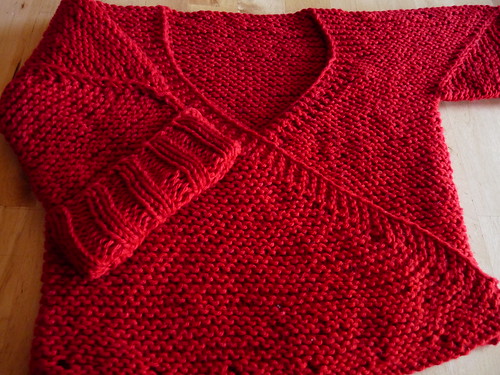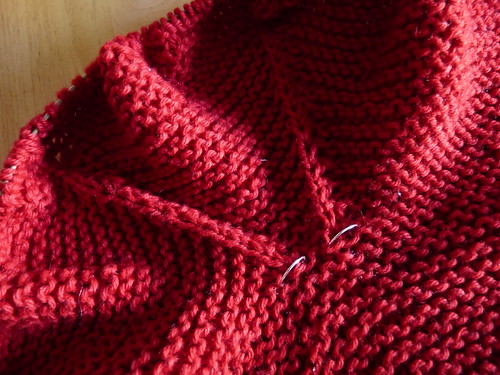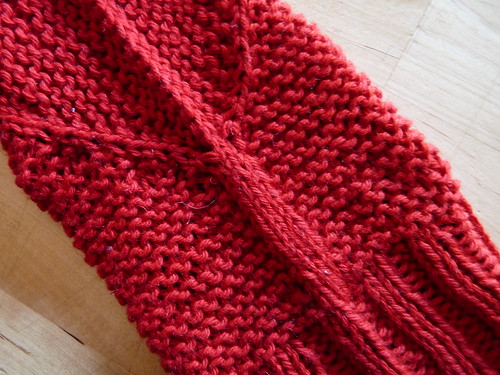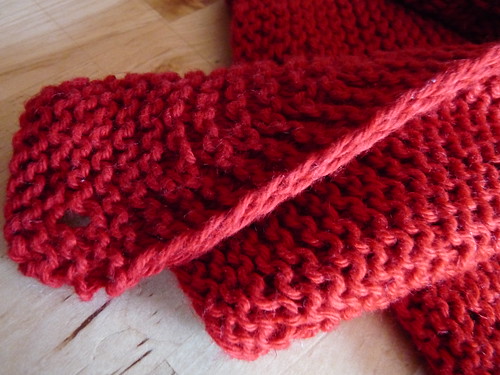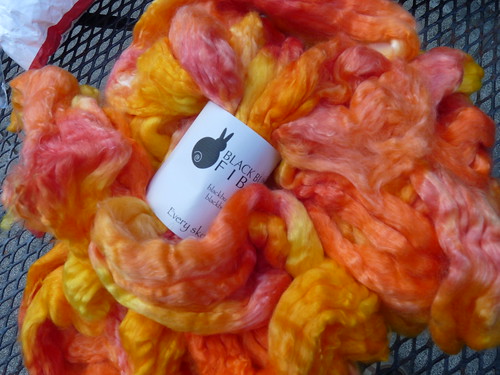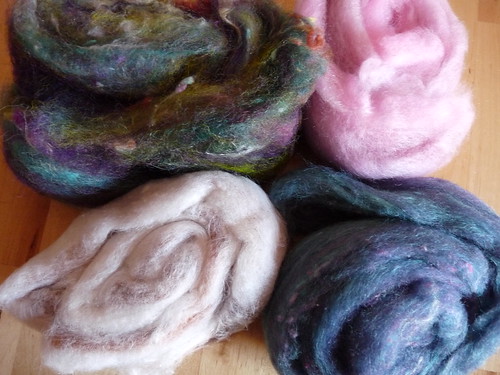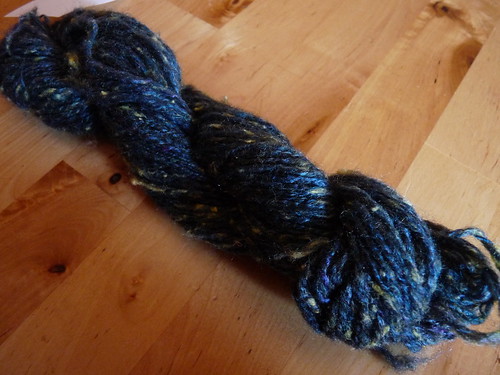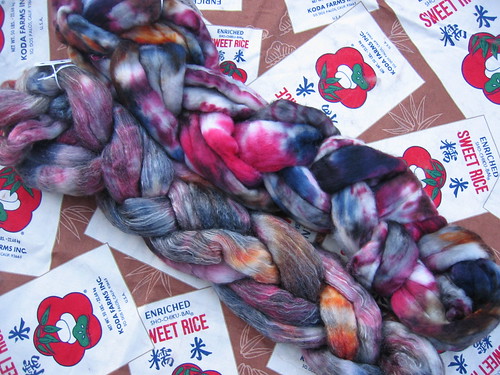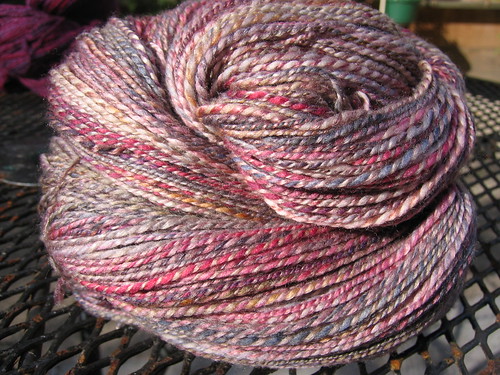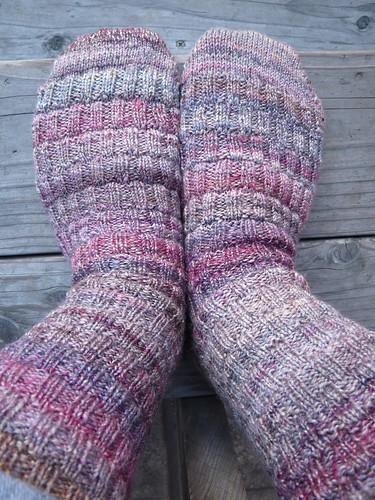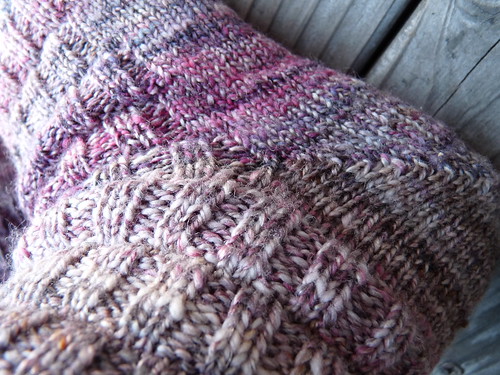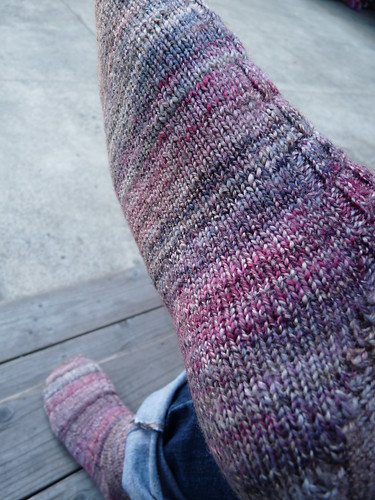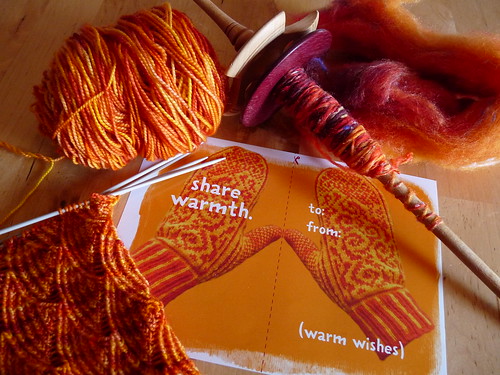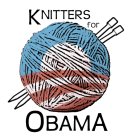Everyone has their own rhythm to combing fleece, and there are excellent youtube vids and blog posts and
magazine articles already covering the subject. I just wanted to throw mine into the mix, not as much for technique but to show yall that the big English combs AREN'T SCARY. Totally accessible. Cheaper than a drumcarder. Make the most beautiful fiber prep. Easy to learn. And fun, fun, fun :)
Most of the technique and terminology I'm using comes from reading
Peter Teal's Hand Woolcombing and Spinning-- it's a really excellent book on the history and technique of combing wool as well as techniques on spinning a 'true worsted' yarn. I've also learned a lot of
great tips on Ravelry and across many, many blogs out there.
You may remember this heartstoppingly black fleece purchased at the
Monterey Wool Auction, which actually probably wasn't the best choice for illustrative purposes but eh :)
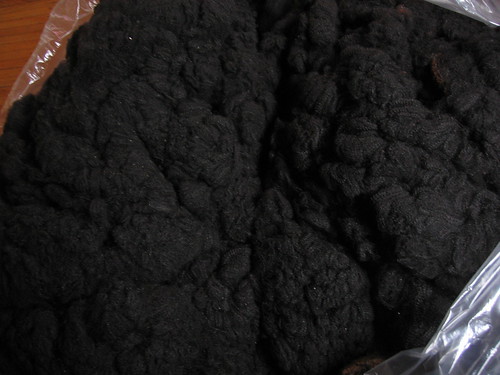
"Kali", ramboullet x corriedale
I'm using
my fine 4-pitch Craftsmith English wool combs-- aK(a) The Big Combs. The pitch is how many rows of tines/poky things there are. The more rows, the more chaff removed by the combs (and the more waste wool) and the more appropriate for fine fibers. The rows on my set are more closely spaced together than on the 'regular' wool combs made by Craftsmith, more closely spaced tines also being ideal for finer fleeces.

The combs are secured on the 'pad', locked in place with a removable pin. The combs can be held upright with the tines facing the ceiling, or on their side parallel to the worksurface (tines facing the walls).My combs didn't come with c-clamps, you'll need some sort of sturdy clamps to hold the pad onto the table/worksurface.
I still
wash all of my fleeces in lock formation, so I lash the butt end (cut end) of my washed locks onto the first and maybe second row of tines of the stationary comb (the one locked to the pad), about 1/3 of the way up. It isn't necessary to arrange all of the cut ends together, but I choose to keep them flowing in the direction they grew off of the sheep when spinning (equivalent to spinning from the tip end). Some people prefer spinning from the butt end of the locks-- all personal preference (and easy to accomplish by just turning your top around after pulling it off of the combs).

Combing is going to add a lot of air and volume to the fibers, and more fiber on the combs can be exhausting/take more passes than if you split it into smaller amounts. The last row of tines on my combs only comes up halfway to the length of the first row of tines-- you need all of your fiber to remain across each row, so more than a third will usually lift up to about the top of the last row of tines when combing.
I use a 1-2% fabric softener (ultra concentrated brand) to water ratio in a spray bottle, and give the lashed-on locks a few squirts of this to control static a minute before combing. Too much liquid means combing becomes difficult and wet...
Teal has you use an oil/water mixture applied to all of the fleece you'll be combing before lashing on, but this way has worked for me (I never know how much I'll be combing that day and the idea of oil is unappealing to me). It's important to only spray your fibers-- spraying the wood on your combs isn't a good idea, and if the tines of your combs *aren't* stainless steel, take caution to really clean and dry them thoroughly before putting away for the day (rust + fiber = not natural dyeing ;))
Lift the locks up about an inch or so from the bottom of the stationary comb and spread them out-- this will help as the bottom of the working comb (held in your hand) will not be able to get close enough to the tines as you work your way in. (See photo below-- the wooden head of the working comb would knock against the wooden head of the stationary comb otherwise). Spreading out the fibers will also help in transferring them.
Turn the stationary comb onto its side, and using your working comb, pass the tips of the comb thru the tips of the lashed on locks ('jigging'). You start gently in an arcing motion, the movement is from the elbow, not the wrist.

Some people like to comb side-to-side (keeping their stationary comb upright/perpendicular to the worksurface, and swinging the comb from left to right or reverse). I understand the safety aspect of combing this way-- there's no way you'll stab yourself in the leg going side to side when combing. For me, I prefer turning the stationary comb to its side since I am putting gravity in my corner-- the weight of the pound and a half comb heading down and into the fiber helps my arm not get as tired in combing as it does when I have to use my own power to go side to side (and fight gravity's downward pull at the same time).
Teal keeps the stationary comb in the sideways position, and lashes back on in the side to side motion. It is a personal preference, no right or wrong. :)
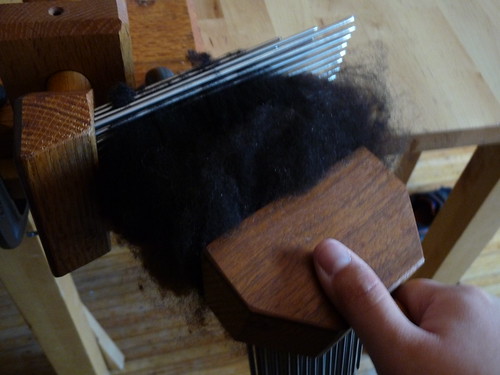
You'll want to choke up on the head of the comb, both to get better leverage/make it part of your arm and also to fight the temptation to swing with your wrist. One smooth motion, down and into the fibers into an arc, and pulling out-- all in the arcing motion. Start from the tips of the fiber to tips of your combs, and work your way slowly in repeating the arcing motion.
After transferring all of the fibers from the stationary comb to your working comb, and removing any waste left behind on the stationary comb (neps, jumbles of fibers caught between the tines, etc), turn the stationary comb upright/perpendicular to the worksurface. Again, turning the working comb in your hand perpendicular to the stationary comb (the combs will always work perpendicularly to one another), begin to transfer the fibers from the working comb to the stationary comb.
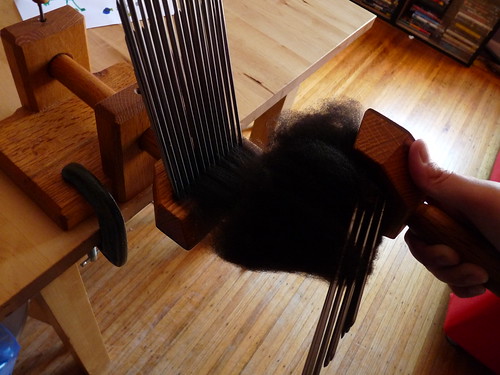
Once again, start from the tips of the fiber and work your way in and down with the arcing motion, transferring the fiber from the working to the stationary comb.
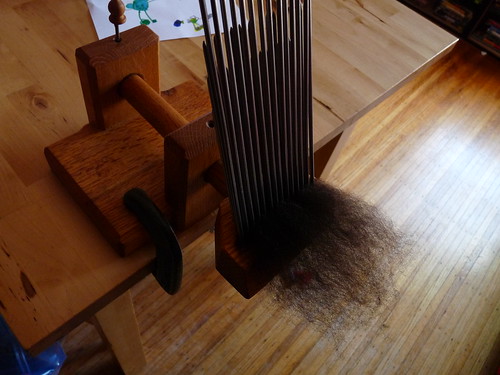
The fibers are already starting to really open up just in this first pass. Once all of the fibers have been transferred from working to stationary comb (and chaff left behind on working comb removed), turn the stationary comb to its side and again work your way in, moving fibers from the stationary to working comb.

Notice how I've moved the fibers upwards from the base of the tines? Still need to do that on every pass so that the wooden heads of the combs can pass close when combing.
After again moving fibers from stationary to working comb and removing chaff left behind, turn stationary comb upright and transfer fibers back to the stationary comb.

You can see that after working your way in to transfer the fibers, you'll move the combs/tines closer and closer together.
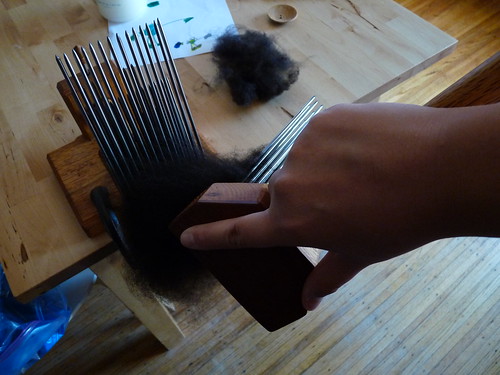
When moving fibers from working --> stationary, I'll often turn my wrist and comb from the opposite side to get all of the fibers from both sides of the comb intermixed. You can easily switch hands to accomplish the same effect.
Finally, once you've made 4 passes (stationary --> working, working --> stationary, stationary --> working, working --> stationary), gather the fibers on the stationary comb together into a cone shaped tip.
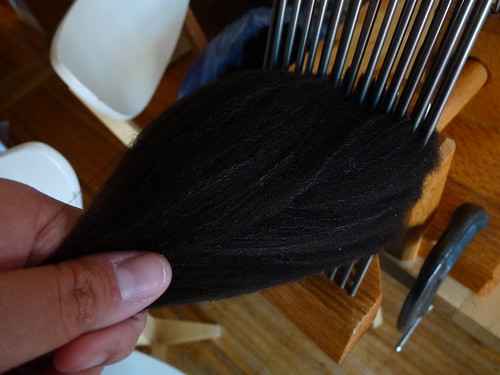
Working hand over hand, gently pull the fibers off together into a long strip. This is what
Teal calls the 'straightening combing.'
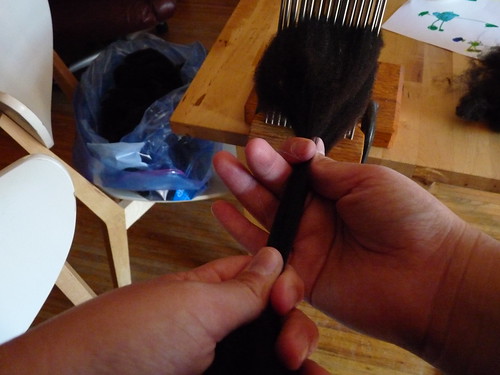
Go slowly, and pull less than a staple's length at a time for an unbroken fiber mass. Don't pull too much without attenuating though, it won't come off at all and just bend your tines. Whenever you're pulling fibers from off the combs, try and alternate the pinching of your fingers so that one pull is from the sides and the next is from the top-bottom (see above)... this will help in pulling fibers from all places of the comb off evenly and together.
It is generally the case that the longer fibers will be pulled off into your rough/'straightening' combing first, and get shorter as you pull. Keep this in mind for blends; by pulling off the rough combing from alternate directions you can help make the rough combing homogeneous.
Pulling the rough combing from the combs in large pinches results in a thick mass. You can always pull off a smaller diameter mass, up to you. Teal's is definitely thinner :)

You can always use a
diz, but since I'm not done I just go hand over hand like above.
When you've pulled off all the usable fiber, you're left with more chaff on your stationary combs.

Removing it, you can see what's left behind in the tines--
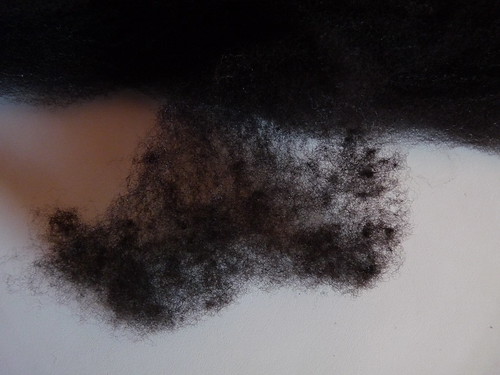
Small neps and short fibers. The "problem" with combing is the waste fiber* removed, you do lose a significant percentage weight-wise. Lots of people will say that you don't want this in your fiber anyways, but it's not always *just* neps, sometimes its unaligned fibers that get trapped in the tines, etc. The more you practice (and the sounder quality of the fleece to start with) the 'cleaner'/less wasteful your waste fiber will be. There are other options for waste fiber as well (recombing it, carding it, felting it...)
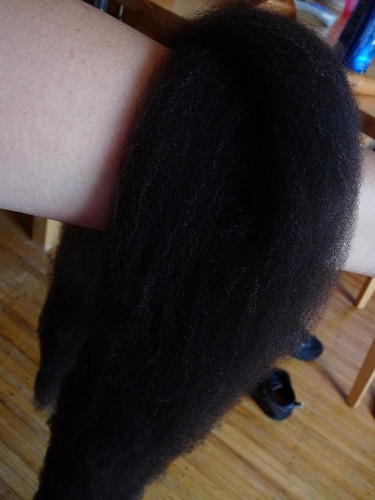
So now you're left with a thick rope of fiber,
Teal's 'straightening' combing. Now, you can easily spin this! I continue on though... already come this far :)
Knowing that the first fibers pulled off of the combs will be the longest, and having a goal of evenly mixed lengths of fibers in the finished product, I split this in half at the middle of the rope, lining up the first pulled off tip (longest fibers) with the first torn bit of the second half (midlength/shorter fibers), 'planking' them. I hold these two lengths together on my hand, maintaining the direction by which the fiber grew off of the animal, and lash the ends onto the stationary comb's tines. It is ends of these lengths I'm lashing on first, ending with the tips (one of which was the first length I drew off in the rough combing.) The result is fiber flowing in the same direction as you lashed on and pulled off.
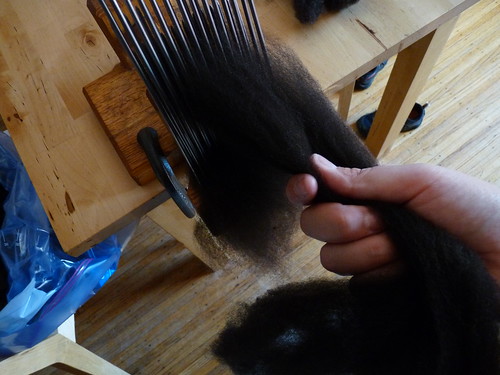
Instead of lashing onto the first and second rows, you want to get the fibers across the back tines as well. Otherwise, they'll just sort of float away, as airy as they are now. Move back to front with the mass of fiber in your hand, twisting your wrist so you get an even distribution of fibers from both halves of your rough combing onto the stationary comb.
You could always split your straightening combing in half and place the first and last ends drawn off together for an even more homogenous mix of fiber lengths, but then the fibers won't flow in the same direction. Again, personal choice-- I prefer to start with staples that are similar in length to begin with and work as above.
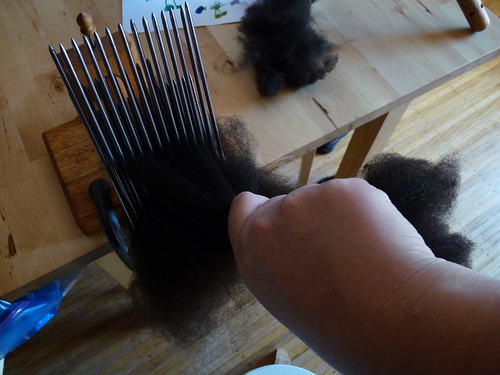
Once again, turn the stationary comb to its side, pull the fibers up from the base and spread them out, and starting at the tips, begin to transfer the fibers onto the working comb with the arcing motion.
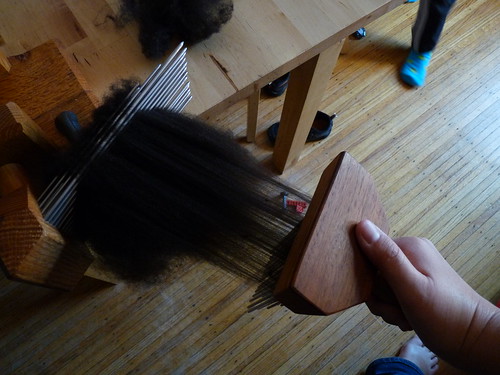
Once all the fibers have been transferred and the waste left behind removed, turn the stationary comb upright and begin to transfer the fibers from the working to the stationary comb.
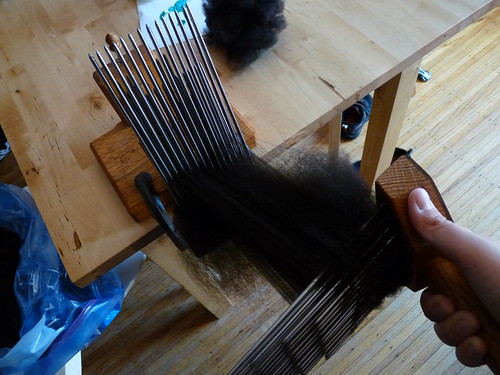

Again, when I am transferring fiber from the working to the stationary comb, I turn my wrist to move fibers from both the left and right sides of the working comb. I will turn the stationary comb in the pad when transferring from the stationary to the working, but mainly to just get all of the fibers off of the comb (and not as much for trying for a homogeneous mix).
So, now that I've done two passes of the rough combed fiber (stationary --> working, working --> stationary) I am left with nicely combed, hopefully evenly dispersed lengths in the fiber on the stationary comb. Again, I draw the fiber into a cone shaped mass, but instead of pinching the mass and pulling off with my thumbs like the rough combing above, I draw a small amount of fibers from all over the tip of the 'cone,' twist them into a short length, and pull this fine gathering of fiber thru my diz.
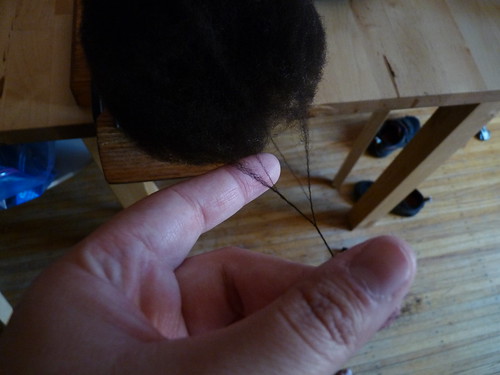
Lately I use the
2mm hole on my diz (still love it); even though the hole is small, you can see how much fiber you can draw thru it. Again, I use the top/bottom and side/side pinching described above when drawing off fibers from the comb and thru the diz.
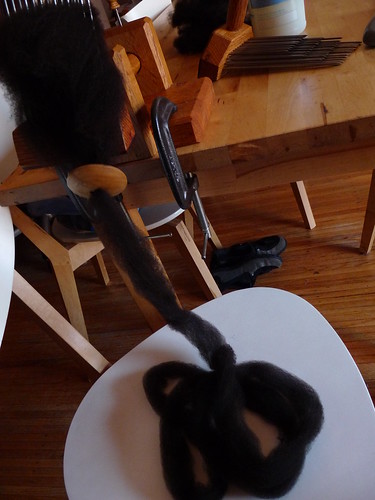
Since most of the chaff and vm in your fleece will fall to the floor when combing, I set out a chair or box to catch the fibers as I'm drawing them off to keep them clean.
At this point, Teal calls this fiber 'sliver'-- instead of 'top.' According to Teal, "[i]n the days of a the professional hand-spinner, the combed sliver was made first into a top and then into a roving." "Top is a collection of slivers wound into a convenient shape for storage and/or transportation," and "[a] roving is made by lightly twisting a sliver to form thick, soft rope." (
p 72) I use one sliver at a time instead of several for fiber storage.
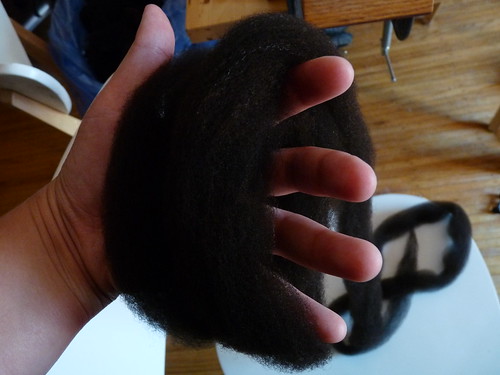
I locate the last bit of fiber pulled off of the combs (representing the butt end of the locks, the shorn end), lightly hold it in the palm of my hand and I twist it gently around my hand into a spiral nest. The wrapping motion adds a slight amount of twist to the sliver, helping it stay together. The last end of the sliver is the tip I first twisted together and pulled thru the diz-- I tuck this end into the center of the sliver, and when spinning look for this end to spin from (so, spinning from the tip of the fiber.) For those that prefer to spin from the butt end of a fiber, you can just reverse the order in which the sliver is balled into a nest.
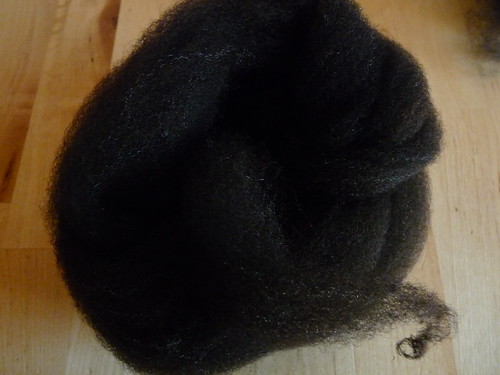
easy to locate over-twisted tip that was used for initially drawing thru the diz
Combing is addicting. Lots and lots of slivers all ready to go!
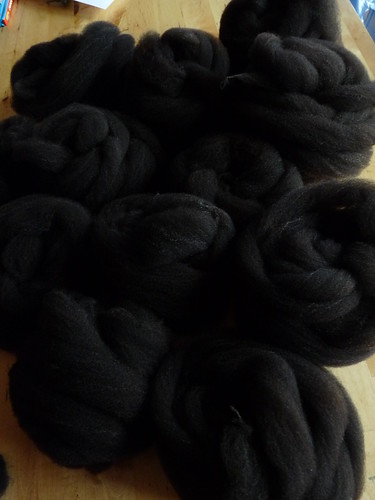
There you have it! Not exactly like Teal, but even when you try it your method won't be exactly like mine either :)
I know this was long, but I just wanted to show yall the wonders of the big combs. I dig combing a lot-a lot, and cringe when I hear people talk about how scary English combs are and how it's an inaccessible thing to try just for their tine length and size. I was hoping that seeing the simple steps would help alleviate some of the unfounded fear surrounding these tools.
I find it easier and less tedious than carding (both on handcards and a drumcarder), and I like the prep more. I have but don't usually comb outdoors-- starting with superclean, mainly vm-free fleece means much of the combing is for pulling into sliver and not dropping dirt onto my floor, so even for apartment dwellers this is an accessible prep. I do have a young child and neither of us has ever been injured by these tools (but we do use caution and care when they're out)-- along with ALL of my fiber tools, we learn that they are not toys early on, and someday will enjoy them together :)
I'm not knocking carders or even the smaller mini-combs, all of which are great tools! I think that there is a misconception about the big English combs though-- that they're not for everybody. They can be!
Happy combing!
* More on waste fibers...
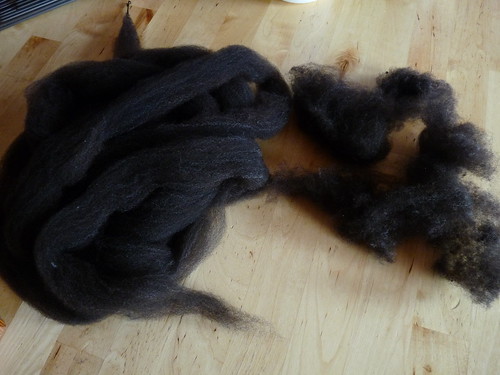
sliver, left and waste, right
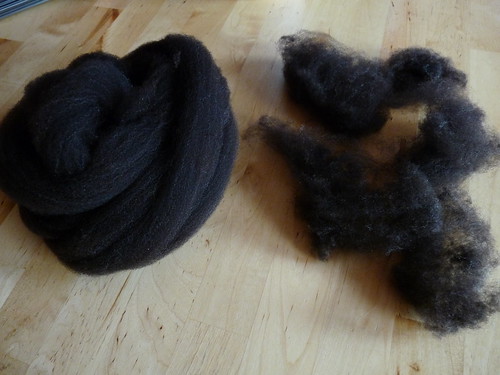
same fiber rolled into a nest, same waste
These fibers were produced combing as described above (4 passes in straightening combing, 2 passes after planking and pulling off).
When I first started combing, I'd get a lot of waste and much of it looked useable, if it weren't jumbled in with the neps and the trash. Practice has really helped; I don't get as many tangled (usable) fibers caught in the tines as time goes on, but still there is the issue of loss. It isn't negligible...
Teal says he has 5% waste loss (!! p 69) and I'm closer to 15-20%. Rita Buchanan in the Winter 1999 issue of
Spin Off says "[i]n my experience, lossed between 10-20% count as normal." (p 26), while the roundtable discussion on "wool combs and combing" in
Spin Off Summer 1991 ranged in answer from "should be less than ten percent" ,"...but most of the time I'd say it's more like 15 to 20%", "[w]ith a weak fleece, you might lose as much as one-third", "[w]ith English combs, I average about 15% waste" (p 58). Using carders you wouldn't see that kind of loss, and for fleeces you intend to comb it's important to remember not only to figure in the lanolin/vm loss when washing but combing loss when figuring how much raw fleece you'll need for a project.
June left a great tip in the comments-- "To really, truly minimize waste - try "precarding" before combing. Drag the butt and tip ends through a handcard (tines up) until the lock is open and airy, like flick carding but easier, it gets the crap out. It makes combing much easier, too."
Again, a personal choice of acceptable losses in fiber preparation-- but I will say that practice has really made a difference in the amount of waste fibers I'm left with after making piles of fiber nests :)
